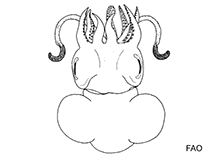Rossia brachyura Verrill, 1883
Hochladen Photos
Google Bild | No image available for this species;
drawing shows typical species in Sepiolidae.
Google Bild | No image available for this species;
drawing shows typical species in Sepiolidae.
Classification / Names Common names | Synonyms | CoL | ITIS | WoRMS
Cephalopoda | Sepiida | Sepiolidae | Rossiinae
Environment: milieu / climate zone / depth range / distribution range Ökologie
Demersal. Tropical
Verbreitung Länder | FAO Gebiete | Ecosystems | Vorkommen | Einführungen
Western Central Atlantic: Greater and Lesser Antilles.
Length at first maturity / Size / Gewicht / Alter
Maturity: Lm ? range ? - ? cm
Life cycle and mating behavior Geschlechtsreife | Fortpflanzung | Ablaichen | Eier | Fecundity | Larven
Members of the class Cephalopoda are gonochoric. Male and female adults usually die shortly after spawning and brooding, respectively. Mating behavior: Males perform various displays to attract potential females for copulation. During copulation, male grasp the female and inserts the hectocotylus into the female's mantle cavity where fertilization usually occurs. Life cycle: Embryos hatch into planktonic stage and live for some time before they grow larger and take up a benthic existence as adults.
Hauptreferenz
Referenzen | Koordinator | Partner
Jereb, P. and C.F.E. Roper (eds.). 2005. (Ref. 1695)
IUCN Rote Liste Status (Ref. 130435: Version 2024-1)
Daten mangelhaft (DD) ; Date assessed: 28 March 2009
CITES Status (Ref. 108899)
Not Evaluated
CMS (Ref. 116361)
Not Evaluated
Bedrohung für Menschen
Nutzung durch Menschen
| FishSource |
Tools
Mehr Information
Trophic Ecology
Nahrungsorganismen
Nahrung
Nahrungsaufnahme
Nahrungsmenge
Räuber
Nahrung
Nahrungsaufnahme
Nahrungsmenge
Räuber
Ecology
Population dynamics
Wachstum
Alter/Größe
Länge-Gewicht
Länge-Länge
Längenhäufigkeiten
Mass conversion
Rekrutierung
Dichte
Alter/Größe
Länge-Gewicht
Länge-Länge
Längenhäufigkeiten
Mass conversion
Rekrutierung
Dichte
Life cycle
Distribution
Human Related
Aquakultur Profil
Stamps, Coins Misc.
Stamps, Coins Misc.
Outreach
References
Internet Quellen
BHL | BOLD Systems | CISTI | DiscoverLife | FAO(Publication : search) | Fishipedia | GenBank (Genom, nucleotide) | GloBI | Gomexsi | Google Books | Google Scholar | Google | PubMed | Tree of Life | Wikipedia (Gehe zu, Suchen) | Zoological Record
Estimates based on models
Preiskategorie
(Ref. 80766):
Unknown.



